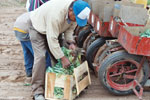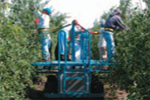Packing House Slips, Trips & Falls
Introduction – epidemiology
There are no published studies looking specifically at slips, trips and falls in fruit packing, however, this hazard is widely reported, and has been documented in a wide range of other food processing operations While these types of falls are generally less serious than falls from a height, they often lead to serious disability and long recovery times, particularly among older workers. As with other kinds of traumatic injury, the unique aspect for farmworker patients is the context in which they occur, and the likelihood for recurrence if work environments and practices are not modified.
The clinician has an important role in making the farmworker patient aware of the range of contributing factors to slips, trips and falls, and to assist him/her in considering what factors might reasonably be altered to prevent re-injury. In addition, an injured worker may be more vulnerable to future injury.
The WORKSITE VISIT section of this website is designed to assist the clinician understand the activities involved in the farmworker patient’s work. After an occupational injury occurs, it may be helpful to review the patients work task videos to discuss how the injury occurred, and how it may be prevented in the future.
In order to assist farmworker patients in thinking through all of the factors that contribute to injury on farm, we can use the following three-part model from injury epidemiology. This model divides injury causes into three broad categories: characteristics of the victim, characteristics of the thing that injured him/or her, and the characteristics of the physical and social environment. Using this model, we can think about a wide range of factors commonly involved in falls and other traumatic injury. The purpose of this is to help patients understand the multiple factors that contribute to injury, and to consider which things over which they may feel they have some control.
| Common Victim Characteristics |
Injury Sources and Their Characteristics | Work Environment Characteristics |
|---|---|---|
|
|
|
Farmworker diagnosis and treatment links:
- Treatment and return to work, by M Rowland, Migrant Clinicians Network. (Go to page 7).
- Workers compensation, by S Davis, Migrant Health Newsline.
Farmworker prevention and education links:
Publication List
- Hofmann J, Snyder K, Keifer M. A descriptive study of workers’ compensation claims in Washington State orchards. Occup Med (Lond). 2006 Jun;56(4):251-7. Epub 2006 Apr 20. PMID: 16627546
- Salazar MK, Keifer M, Negrete M, Estrada F, Synder K. Occupational risk among orchard workers: a descriptive study. Fam Community Health. 2005 Jul-Sep;28(3):239-52. PMID: 15958882
 Muscle Strain
Muscle Strain Falls
Falls